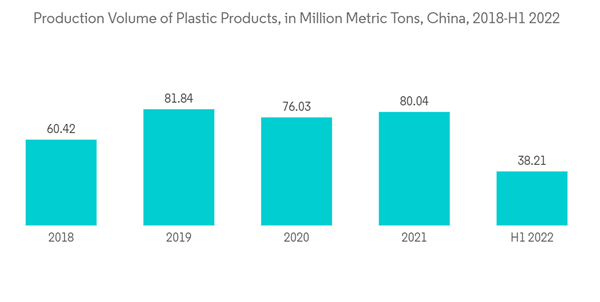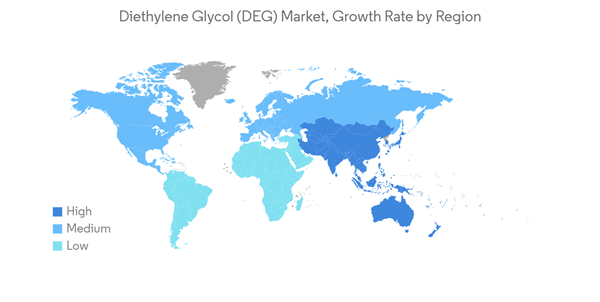The COVID-19 pandemic negatively impacted the market. It was because of the shutdown of the manufacturing facilities and plants due to the lockdown and restrictions. Supply chain and transportation disruptions further created hindrances for the market. However, the industry witnessed a recovery in 2021, thus rebounding the demand for the market studied.
Key Highlights
- Over the short term, increasing demand from the construction and paints and coatings industries in emerging economies such as India and China are factors driving the market's growth.
- On the flip side, regulations restricting DEG use due to its toxic nature and volatile prices of raw materials are some of the factors restraining the growth of the market studied.
- However, increasing demand for diethylene glycol as a chemical intermediate in the chemical industry due to increased downstream uses in PET resins and the textile industry are the major opportunities to drive the market in the future.
- The Asia-Pacific region dominates the world and will be the fastest-growing market due to increased infrastructure development and rapid industrialization.
Diethylene Glycol (DEG) Market Trends
Increasing Demand in the Plastics Industry
- Diethylene glycol is an organic compound produced by partial hydrolysis of ethylene oxide. It is a colorless, odorless, low volatility, and low viscosity liquid with a sweet taste.
- Increasing the use of diethylene glycol as raw material in producing plasticizers for paper, cork, and synthetic sponges, the demand for diethylene glycol is rising in the plastic industry. It is expected to drive its market during the forecast period.
- Diethylene glycol is also used for producing plastic materials like polyurethane. It is used for the insulation of refrigerators and freezers and as a coating and sealant material in the automobile industry. For instance, according to OICA, in 2022, automobile production in the United States amounted to 1,00,60,339 units, which showed an increase of 10% compared to 2021. As a result, an increase in automobile production is expected to create demand for Diethylene glycol (DEG).
- China is the largest polyurethane raw materials and product producer in the global market. For instance, according to the National Bureau of Statistics of China, in 2021, China's total production of plastic products amounted to 80 million metric tons, which showed an increase of 5.27% compared to the previous year (2020). Therefore, an increase in the production of plastic products in the country is expected to create demand for the Diethylene glycol (DEG) market in the country.
- Owing to all the factors mentioned above diethylene glycol market is expected to grow rapidly over the forecast period.
The Asia-Pacific Region to Dominate the Market
- In countries like China and India, the demand for diethylene glycol is increasing in the region due to increasing government spending on infrastructure development and rapid industrialization.
- The increasing need for products, such as polyester resins and polyurethanes, in various end-user industries, like construction and building, plastic, and automotive, is projected to boost the demand for diethylene glycol in the region. It acts as a chemical intermediate for their production. Moreover, the rising production of various chemicals in Asia-Pacific countries impacted the market growth.
- According to the Federation of Indian Chambers of Commerce and Industry, the Indian government recognizes the agrochemical industry as one of its top 12 industries to achieve global leadership, growing 8-10% through 2025. Thus, India's agrochemical sector is projected to grow during the forecast period.
- According to the China National Coatings Industry Association, in China, the demand for coatings in the country is likely to grow by 8% with the support of building and construction and automotive manufacturing. For instance, according to OICA, in 2022, automobile production in China amounted to 2,70,20,615 units, which showed an increase of 3.3% compared to 2021. Therefore, increasing the production of automobiles in the country is expected to consume more paints and coatings, creating an upside for the diethylene glycol (DEG) market.
- China and India are the top two largest populated countries, which are still developing. So, huge growth is expected in the agrochemicals, paints and coatings, and personal care industries. For instance, in 2022, over 328 thousand housing units were launched across India's residential market. Even though there is high demand for housing in the country, residential launches are on a comparatively high level over the past few years. Therefore, increasing demand for architectural coatings is expected to boost the diethylene glycol market.
- Owing to the abovementioned factors, the Diethylene glycol (DEG) market is projected to grow significantly during the study period.
Diethylene Glycol (DEG) Industry Overview
The diethylene glycol market is highly fragmented. Some of the major players in the market include (not in any particular order) Reliance Industries Limited, SABIC, Dow, Huntsman International LLC, and Shell, among others.Additional Benefits:
- The market estimate (ME) sheet in Excel format
- 3 months of analyst support
This product will be delivered within 2 business days.
Table of Contents
Companies Mentioned (Partial List)
A selection of companies mentioned in this report includes, but is not limited to:
- Crystal India
- Dow
- GC Glycol Company Limited
- Huntsman International LLC
- India Glycols Limited
- Indorama Ventures Public Company Limited
- Merck KGaA
- Mitsubishi Chemical Corporation
- Nippon Shokubai Co. Ltd
- PETRONAS Chemicals Group Berhad
- Pon Pure Chemicals Group
- Reliance Industries Limited
- SABIC
- Shell PLC
- Tokyo Chemical Industry Co. Ltd










